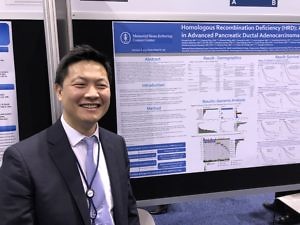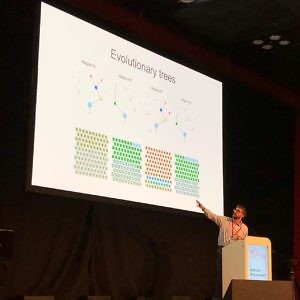How understanding patient tumours can help us with future IO trials
In wave 3 of the immuno-oncology surge things have slowed down, partly due to a raft of combination trials yet to read out and partly because the reality has finally hit that tumour heterogeneity means there will be variable patient responses.

Just getting from room to room on time can be a real challenge with 40,000 other people present!
This complexity can come about in many forms… immunosuppression, alterations in gene functions, resistance and immune escape, to name a few.
If we want to help more people respond to these therapies then before we can rush headlong into another round of combination trials, we first have to go back to looking carefully at the underlying biology of the diseases and listen to what the patient’s tumours are telling us in order to fix things.
To accomplish this feat requires considerable time, energy, effort, and a lot of bioinformatics.
In this post we explore five key talks that highlight different aspects of biomarkers of response and mechanisms of resistance. From there, we may see additional validation and prospective testing to determine how best to segment people so that they have the greatest chance of responding to the therapy administered.
One thing that most people don’t have these days is time, which is how we can help you because here’s a handy short cut to finding out more about five complex and diverse areas on biomarkers or IO resistance quickly and easily…
To learn more and get a heads up on our latest oncology insights and conference analysis, subscribers can log-in or you can click to gain access to BSB Premium Content.
This content is restricted to subscribers


 I particularly wanted to post some thoughts and commentary on the ongoing Macrogenics story around margetuximab, an anti-HER2 antibody that binds with elevated affinity to both the lower and higher affinity forms of CD16A, an Fc receptor.
I particularly wanted to post some thoughts and commentary on the ongoing Macrogenics story around margetuximab, an anti-HER2 antibody that binds with elevated affinity to both the lower and higher affinity forms of CD16A, an Fc receptor. One of the highlights of medical and scientific meetings we go to is meeting early career researchers, especially those who are doing translational research.
One of the highlights of medical and scientific meetings we go to is meeting early career researchers, especially those who are doing translational research.



 There are quite a few possibilities emerging, although to be fair, some of them will no doubt go by the wayside over the next year or two. There has already been quite a bit of attrition since 2015/16. Figuring out which ones will be a target versus being a useful marker is also an important aspect of new product development.
There are quite a few possibilities emerging, although to be fair, some of them will no doubt go by the wayside over the next year or two. There has already been quite a bit of attrition since 2015/16. Figuring out which ones will be a target versus being a useful marker is also an important aspect of new product development.
 In other words, we need more firepower and novel rational combination approaches to stimulating both the innate and the adaptive immune systems in order to derive a more potent and durable response in a larger number of patients. That’s where TLR agonists come in.
In other words, we need more firepower and novel rational combination approaches to stimulating both the innate and the adaptive immune systems in order to derive a more potent and durable response in a larger number of patients. That’s where TLR agonists come in.